The crystalline salt contains nitrogen and sulfur, which plants need to create proteins. Ammonium sulfate has a stimulating effect on many physiological processes in cells. Fertilizer is applied in the spring, vegetables and other crops are fed during the growing season to obtain a quality crop.
Material Content:
What is ammonium sulfate fertilizer
According to one of the classifications, mineral salt is called "ammonium sulfate." These are colorless crystals or small white granules. The formula (NH4) 2SO4 gives an idea of what fertilizer is ammonium sulfate in terms of chemistry. The composition contains 21% nitrogen and 23-24% sulfur. In the form of ions, these essential elements are readily available to plants.
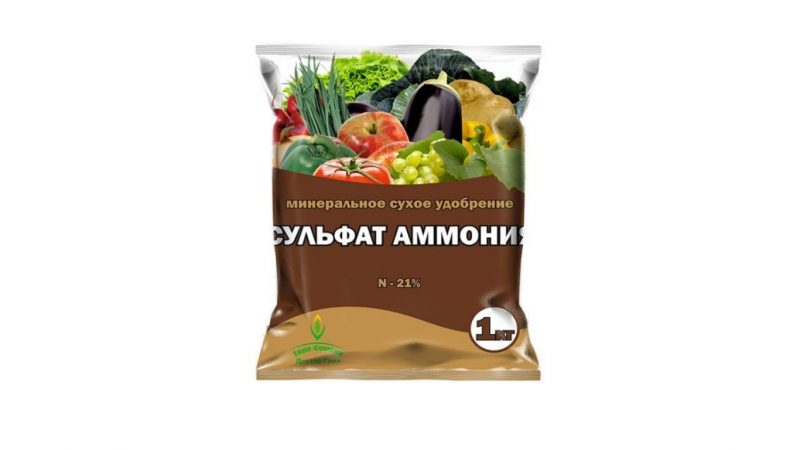
At room temperature, about 750 g of ammonium sulfate dissolves in 1 liter of water. The solution has a slightly acidic reaction. Crystals melt at a temperature of 235-280 ° C. With further heating, the substance decomposes with the release of ammonia, sulfur dioxide and water.
Useful properties for plants
Nitrogen and sulfur are part of amino acids - "bricks" to create enzymes and other protein substances. They regulate all processes in the cells, increase the productivity and vitality of plants. Sulfur also contributes to better absorption of most macro and micronutrients.
Ammonium sulfate works best on neutral and alkaline soils, increases the efficiency of other fertilizers: nitrogen, phosphorus and potash.
Ammonium salt is applied in the fields for cereals, sunflowers and canola, enriching the soil in orchards and summer cottages.In spring, nitrogen and sulfur provide intensive development of roots and shoots, laying the future crop. A shortage of essential nutritional components delays growth and worsens product quality.
The use of ammonium sulfate
Fertilizer can be used as the main, as well as for feeding. Good results are provided for growing vegetables. It is recommended to apply during irrigation.
Vegetables and Potatoes
The ammonium compound is a highly effective source of nitrogen for potatoes, which is not afraid of soil acidification. It can be used on heavy soils in spring and autumn.
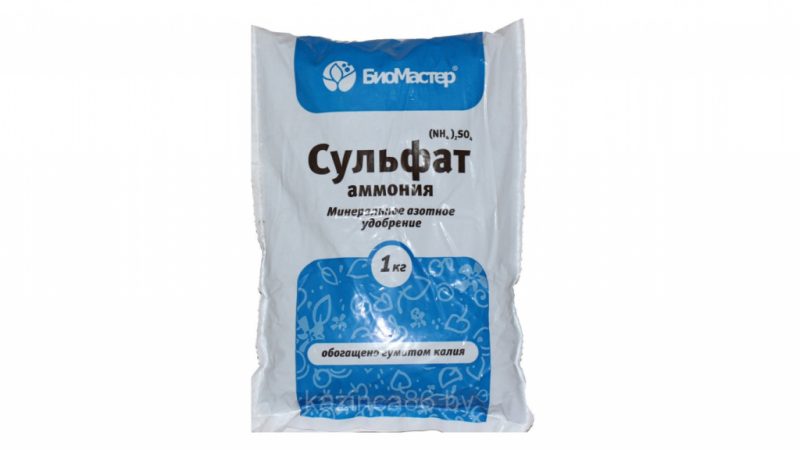
There are plants that require sulfur content that require an ammonia form of nitrogen. This group includes cabbage, potatoes, rape and a number of other crops. A slightly acid soil reaction is favorable for carrots, radishes, tomatoes. The introduction of ammonium sulfate is effective when growing parsley, radish, zucchini, pumpkin.
Fruit trees
Fertilizer of fruit stands needs to be given no less attention than other agricultural activities. Fruit trees need nitrogen for normal growth of vegetative parts, regular fruiting, and increased yield. Ammonium sulfate is scattered around the trunk and, by digging, is sealed to the desired depth.
Part of the nitrogen must come with mullein and compost. A mixture of organic fertilizers with ammonium salt is useful for growing and increasing the yield of fruit stands. Top dressing works better if they are used in dissolved form. 9 parts of water and 25 g of ammonium sulfate are taken per 1 part of mullein.
Berry bushes
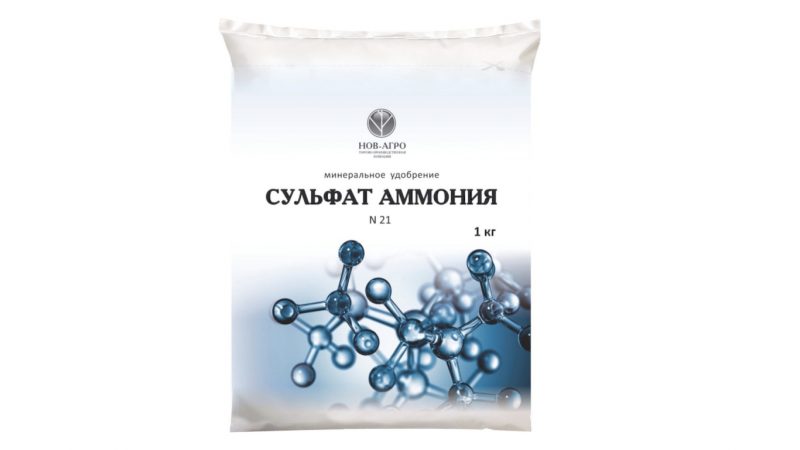
Ammonia nitrogen and sulfur improve the growth of gooseberries and raspberries. These berry bushes bear fruit better when the acidic reaction of the soil, which creates a solution of ammonium sulfate.
Flower crops
Ammonium sulfate is introduced under many types and varieties of flowers. Mineral fertilizer is better absorbed when used together with mullein and bird droppings. Preliminarily, the organics are diluted with water 9-12 times. Then add a solution of the right amount of mineral fertilizer. Such a liquid requires 3-5 liters per 1 square meter.
Instructions for use of sulfate
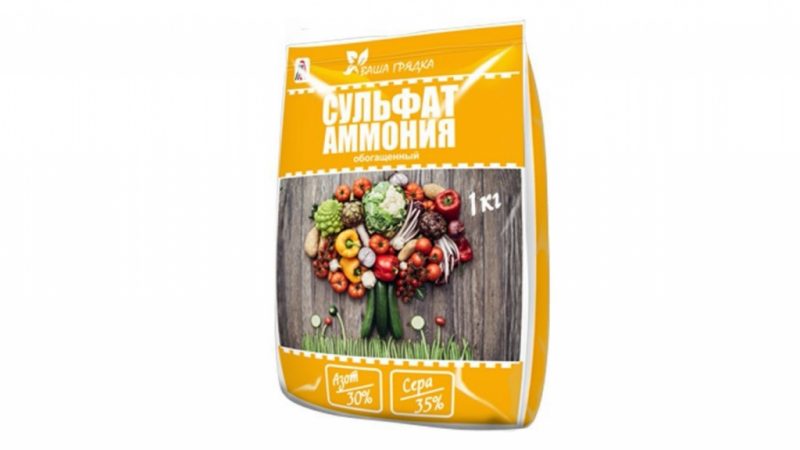
On heavy soils, you can use ammonium salt as the main fertilizer, without fear of leaching of nitrogen. Acidic substrates are recommended to be preliminarily calcified, since the salt undergoes hydrolysis, and as a result, the pH decreases. To neutralize 1 kg of ammonium sulfate add 1 kg of lime.
Fertilization time
Crystalline or granular ammonium sulfate in the spring is evenly scattered over the soil surface. Feeding with solutions is carried out in early spring and again after 2 months. You can add other nitric as well as potassium salts in liquid form.
Dosage
It is advisable to apply fertilizer in wet weather, so that the substances quickly penetrate to the roots and are absorbed by plants. In the event of prolonged drought, watering is required.
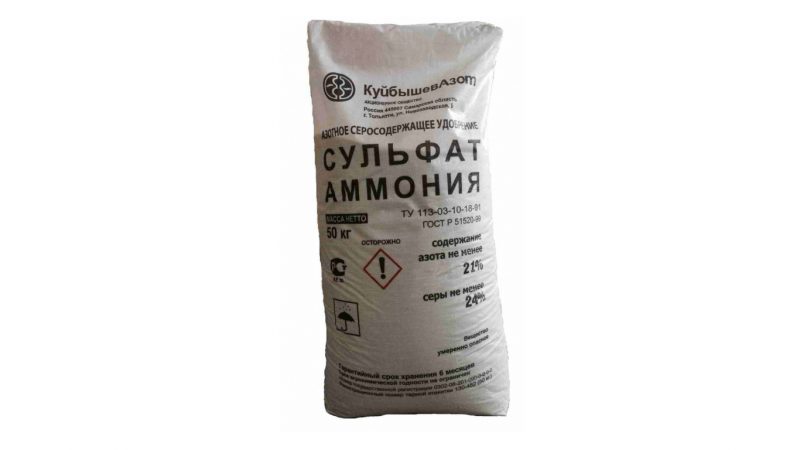
Recommended doses of ammonium sulfate (g / m2):
- radishes, carrots, radishes, parsley, zucchini, pumpkin, tomatoes - 30–35 g / m2;
- white and Brussels sprouts - 60;
- cauliflower, broccoli, kohlrabi - 45;
- under other vegetable crops —30–50;
- red cabbage - 75;
- onions, lettuce, spinach, asparagus - 50;
- ornamental shrubs - 50;
- potatoes - 70;
- strawberries - 50;
- grapes - 60;
- fruit trees 40;
- gooseberries and raspberries - 50-60;
- other berry crops - 40-50.
Ammonium sulfuric acid should be stored in closed, dry, clean, well-ventilated areas. Can be placed in the same room with ammonium phosphate, potassium chloride.
Pros and cons of using fertilizer
The introduction of ammonium salt has a positive effect on the yield of many crops. The fertilizer is completely soluble in water, well absorbed by plants. With normal moisture, it is slightly washed out of the soil (compared to nitrates).
Ammonium sulfate does not burn, is explosion-proof, does not cake during storage. This fertilizer is cheaper than urea and nitric acid salts used in agriculture. On the packaging manufacturers indicate: "Without nitrates." Indeed, there are no such compounds in the composition.
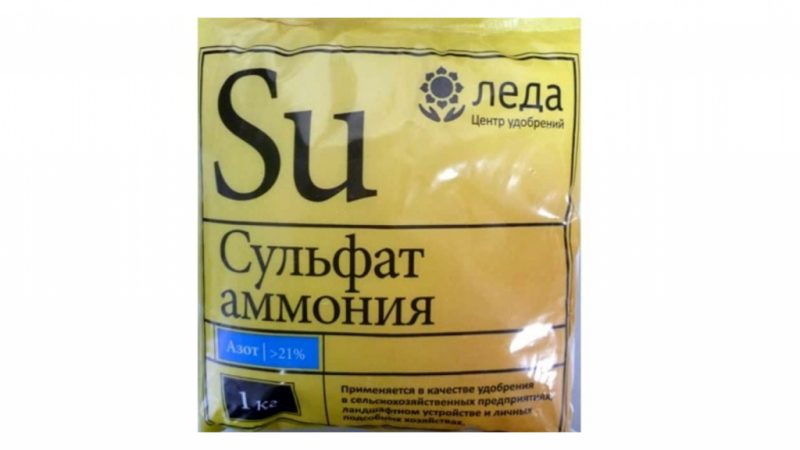
Ammonium fertilizers are used by plants at 60–70%, carbamide and nitrate - only at 40-50%.
Conversion of ammonium sulfate to nitric acid in the soil is possible. This process reduces the nitrogen content, leads to the accumulation of nitrates. They are more easily washed out in irrigated areas when a large amount of precipitation occurs. Nitrogen losses are reduced when using granular fertilizers, although they are more expensive, they act more slowly on plants.
Ammonium sulfate is an affordable mineral compound for basic application and top dressing. The use of fertilizer increases the quantity and quality of the crop. To get a good result, it is important to follow the dosage. To reduce nitrogen loss, it is recommended to use ammonium sulfate immediately before sowing, to make the required dose in fractional portions during the growing season.












